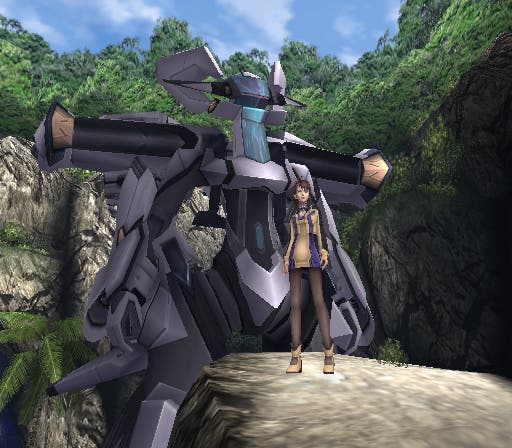Xenosaga Episode III: Also Sprach Zarathustra
The saga concludes.
But despite all these sky-high barriers to entry, with a little dedication and the aforementioned encyclopaedia, Xenosaga III is still playable for a newcomer. And, although seemingly interminably slow-burning, the game does move towards a grandiose and largely satisfying conclusion with grim determination and some moments of genuine beauty.
Helpful in spurring the new player along is the slick battle mechanic, which is very straightforward to pick up. There are no random battles in Xenosaga III - enemies are visible in the field and you can use the environment pre-fight to your advantage by laying traps or attacking from behind (although this doesn't always work as smoothly as one might hope). The transition to battle mode is near instantaneous which gives the game a fast pace lacking from many modern RPGs, and that was certainly missing from the first two games.
For the first time in the Xenosaga series, attacking during battle is done by making selections from a menu rather than using face buttons to perform various combos. When on foot characters can use basic melee attacks as well as techniques and magical ether moves, the latter two of which incur penalties for use. Damaging enemies fills a boost meter, which can be used to gift your characters extra turns and is far better balanced than in the previous game.
A new type of break meter is the main addition for the series (replacing the previous confusing break zone). When both allies and foes are attacked the break meter fills until, when full, it encumbers the character for two turns during which time they can't make any moves, offensive or defensive. It's hardly Grandia III territory as far as exciting battle mechanics go but it works well and, for the first disc at least (after which fights become considerably harder and death is a strong possibility in each skirmish), battles start and end quickly and satisfyingly.

The other battle mode is inside the E.S. mobile suits - the giant mechanised war machines so beloved of Japanese futuristic fiction. Each is equipped with an artefact called a Vessel of Anima that allows the unit to get charged up and use large-scale attacks. The E. S. fights are a far cry from the staid battles of Xenosaga 1 with exuberant animations darting through space and darting tag-team combination moves. Finishing enemies with a special move in either mode grants the party extra experience bonuses and, team management wise, the Final Fantasy X-esque skill upgrade system makes a return.
Outside of battles gameplay is extremely straightforward. Corridors and environments have very simple pathways to negotiate, sometimes with some simple lock and key mechanisms, and a few hidden chests and items scattered around. Essentially though, these on-field sections are really just the paragraph breaks in between the lines of drama. Some more traditional side-quests and an interesting grid-based puzzle game replace the dull card-battling game from Episode II as a diversion but as far as interaction goes that's your lot.
Indeed, so much emphasis is placed on the cut-scenes that Namco has included a facility where pressing select during any conversation will make the dialogue automatically progress. By removing that last bastion of interactivity (the press-X-to-advance conversation) the game nails it's aspirational movie hopes clearly to the mast. Perhaps even more telling is that this is a welcome feature for the player as it makes cut-scenes flow naturally and enjoyably.
These cut-scenes quickly start to tie up Xenosaga's loose ends in Episode III - and well they should, the first two instalments having convoluted their narrative into a tangle of unconsummated confusion. For those that have journeyed along with the game, the narrative endgame proves surprisingly satisfying.
Taken as a series Xenosaga's presentation is a horrible mess of incongruity. Visually, the first game demonstrated stylised super-deformed characters while Episode II plumped for more realistic forms. This final game opts for the middle ground while at the same time downgrading the audio from 5.1 to mere stereo. Episode III sees many of the voice actors from Episode I that had been discarded or Episode II make a return - all cardinal sins of universe inconsistency from Namco.
Indeed, this is a saga that has clearly been tugged and squeezed, compromised and spoiled by many, many cooks. So, in the end, has it all been worth it? If you're the kind of person whose waded through this review then it's likely you have the right temperament for the game's indulgences and will find merit beneath the unwieldy framework and unfashionable aping of cinema. But if you're the kind of person that skipped the body of critique to look at the pay-off score below then walk away now. This is a conclusion whose delight is in the long haul earning - not in the snatching.
